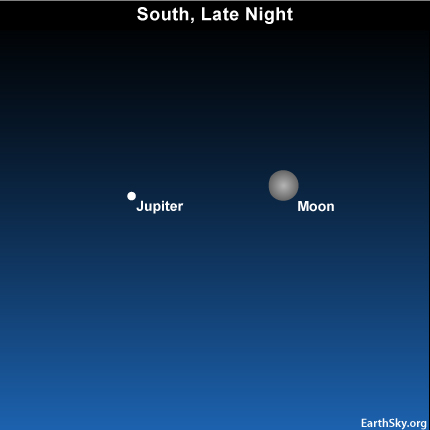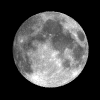Courtesy of EarthSky
A Clear Voice for Science
www.EarthSky.org
 Comet Hartley 2 might brighten to binocular object by late September 2010
Comet Hartley 2 might brighten to binocular object by late September 2010
 In 2010, Jupiter came closest to Earth on September 20 – yesterday – at 21 hours Universal Time (4 p.m. Central Daylight Time). Then Jupiter was only 368 million miles away.
In 2010, Jupiter came closest to Earth on September 20 – yesterday – at 21 hours Universal Time (4 p.m. Central Daylight Time). Then Jupiter was only 368 million miles away.
Today Earth passes between the sun and Jupiter, placing Jupiter opposite the sun in our sky. Astronomers call this event an opposition of Jupiter. The 2010 opposition is Jupiter’s closest since 1963. In addition, Jupiter is near tonight’s moon.
The giant planet is now lighting up the September night from dusk until dawn. It will remain close and bright throughout the second half of September. Although it will dim slightly by October, more people will notice Jupiter next month, because it will appear in the east already as the sun is setting in the west.
Why is Jupiter closer at some oppositions than others? It is because Jupiter’s orbit – like Earth’s orbit – is not perfectly round. Jupiter happens to be near its closest point to the sun in its 12-year orbit around the sun. That closest Jupiter-sun distance will come in March 2011. We are passing between Jupiter and the sun – so Jupiter is closer to us than usual at this year’s opposition. Jupiter will not come this close to Earth again until the year 2022.
Jupiter comes to opposition every 13 or so months, as Earth takes this long to travel once around the sun relative to Jupiter. Jupiter’s closest approach to Earth for the year always falls on or near this planet’s opposition date. In 2010, Jupiter came nearest to Earth on September 20, at 21 hours Universal Time (3 p.m. Mountain Daylight Time).
However, Earth flies in between the sun and Jupiter today at 12:00 Universal Time. That is 6 a.m. Mountain Daylight Time on September 21. When it is opposite the sun, astronomers say that Jupiter is in opposition. The king planet now rises in the east at sunset, and sets in the west at sunrise. At midnight, Jupiter climbs highest in the sky, and because it is opposite the sun around now, you can see Jupiter at any time of night. For example – as today’s chart shows – you can see it in the south at midnight tonight, when the sun is below your feet. At dawn tomorrow, you will see Jupiter low in your western sky. At opposition, Jupiter shines at its brightest in our sky.
You would need at least 80 Jupiters – rolled into a ball – to be hot enough inside for thermonuclear reactions to ignite. In other words, Jupiter is not massive enough to shine as stars do. However, Jupiter is the largest planet in our solar system. So, when the sun goes down on these September 2010 nights, you might – if you are fanciful enough – imagine bright Jupiter as a tiny sun all night long.
Jupiter’s greatest distance from us will come when Jupiter is behind the sun from Earth in April 2011. Let us see . . . closest in late September . . . farthest a bit more than six months later in early April 2011. You might see that Jupiter’s distance from us, as well as its location in our sky, is being driven primarily by Earth’s year-long orbit around the sun.
That is because Earth travels around the sun in an orbit that is closer to the sun than Jupiter. Our orbit is smaller, and we move faster in orbit than does the solar system’s king planet. Earth travels at a speed of about 18 miles per second in orbit, in contrast to about 8 miles per second for Jupiter.
Be sure to look for Jupiter near the moon tonight. They will be beautiful on this night of Jupiter’s opposition. And remember, this September 2010 opposition of Jupiter counts as extra special – Earth’s closest encounter with Jupiter since the year 1963!
Astronomy Picture of the Day from NASA/JPL
U.S. Naval Observator Astronomical Information center
The York County Astronomical Society
I just saw it. Truly, it was a marvelous sight. If you have time, dig out your telescopes because we won't see it again for another 12 years (this close at least).
Thank you for publishing this timely and interesting article. It popped up first on my Google search while encouraging my youthful niece and nephew to go look outside.
Watched the eastern night sky for Jupiter sighting & I saw it thru my binoculars. It
was at left of the moon. I found it to be very exciting and was happy I had read the
article telling when you could see it.
I haven’t had my 30 x 100 binos out for over a year, but tonight fortuitously removed them from their case just to take a look at not only the moon, but what was obviously Jupiter rising in the east. Imagine my delight when there she was, sporting clearly a dark belt, with all her Galilean satellites in tow! This is the best view I’ve ever seen (I live in rural Tasmania).
Within minutes I was online to check – and found this article. How about that for a coincidence? I pick tonight of all nights to find out that this is the closest Jupiter has been to my person within the whole of my 45 year life-time!
Thanks for your article Deborah!
I'm looking at the moon right now and can see jupiter only looking with the naked eye so it looks somewhat like a star to me but i was talking with a friend whilst doing this and she noticed a shadow like ring in the sky round both of them that i can also see aswell!!!! I'm no scientist and dont really know alot about things like this….. can anyone else see this or explain what this is??????
Just saw this outside. A marvelous sight even without a telescope. Most of us will see this sight only once in our lifetimes. Thanks for your continuing articles and broadcasts.
Saw the bands of Jupiter and at least two moons with the telescope tonight and it was awesome, this was not by an accident, it was designed by God.
wow! very clear night here in the center of LI. They're so bright & beautiful. What a treat
How come last night and tonight the stars were flickering from red to blue all night?
Thank you for this awesome article! I'm an astronomically huge sucker for astronomy. I'm like a kid in a candy store when it comes to this stuff and I really can't get enough. You're article was perfect and it made my co-workers actually understand what I was talking about tonight. Thank you again!
I understand this is what Galileo saw in 1610. Does anyone know the other years that Jupiter's opposition was so close, in the last couple of centuries? I am curious as to what other world events took place in those years.
Worth waking up at 3:a.m. , which is usually annoying. Bedroom is flooded with moonlight. I am with Galileo and all the future viewers as long as this amazing universe lasts. Corny? Yep.